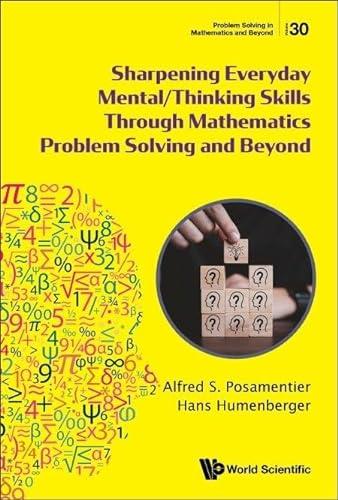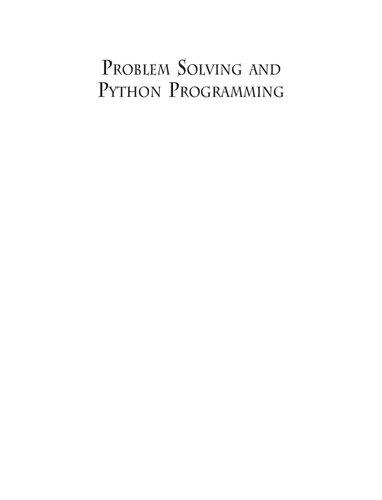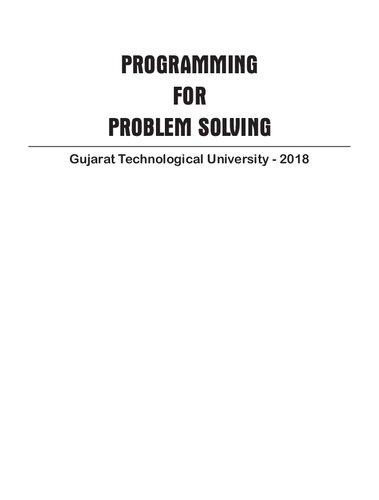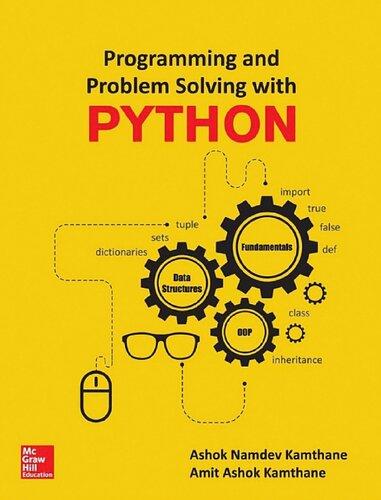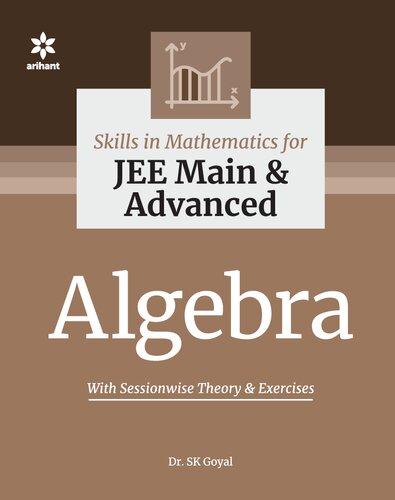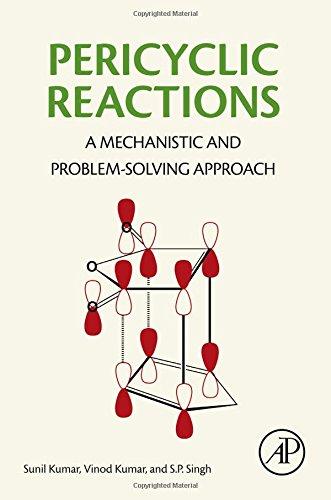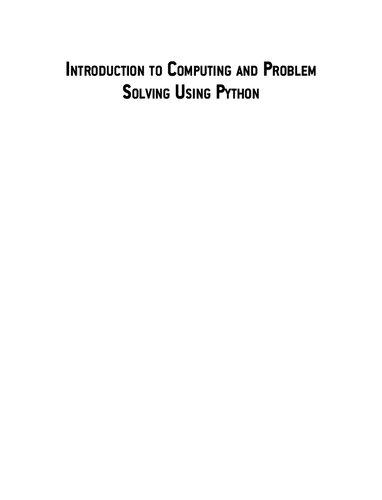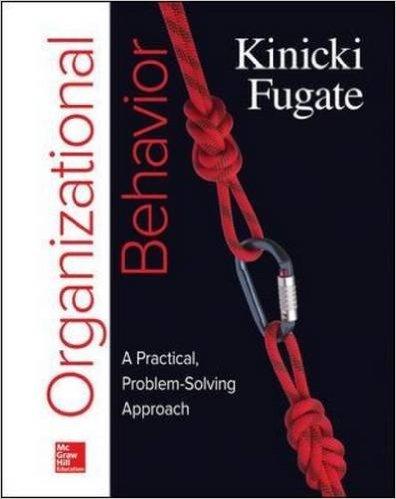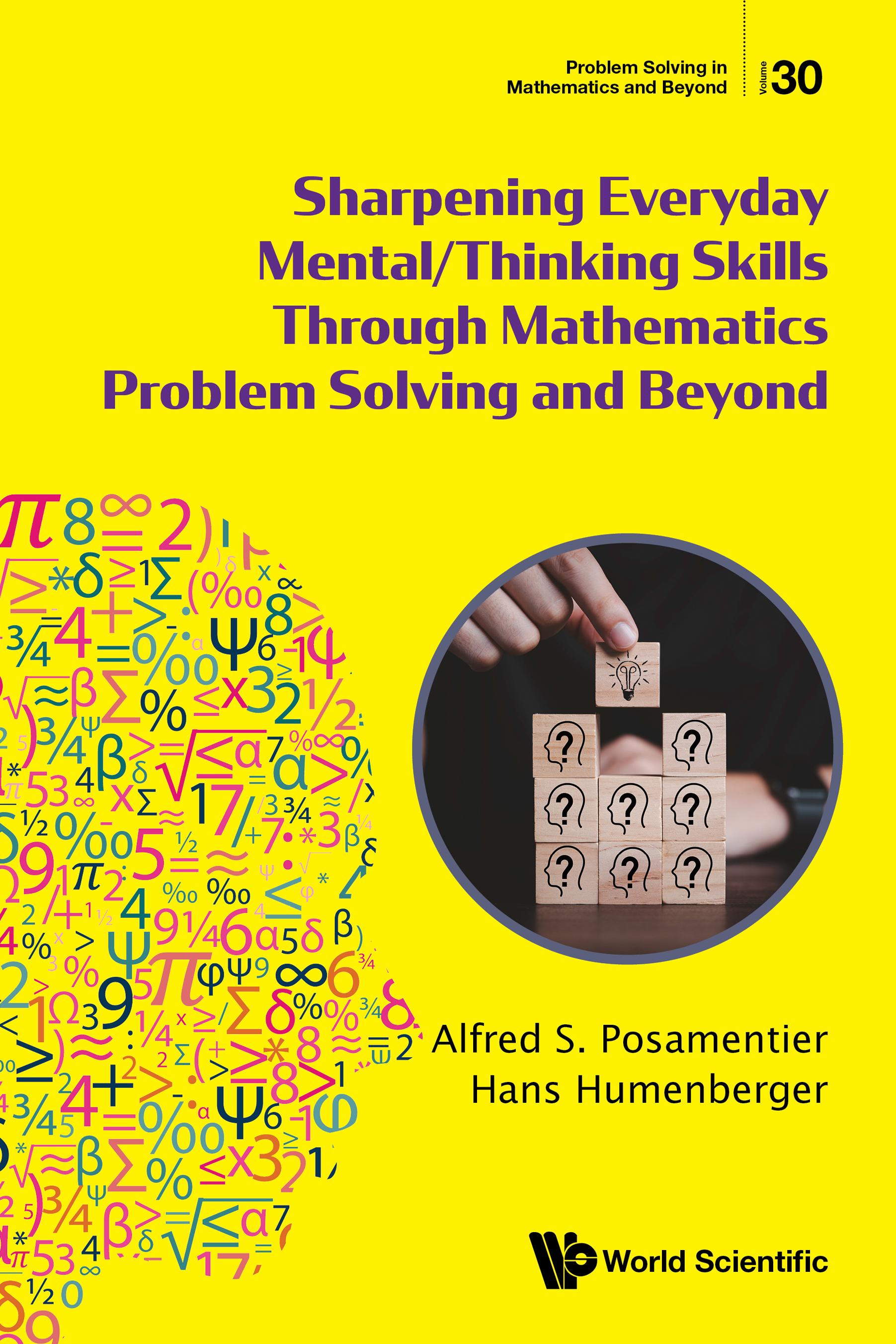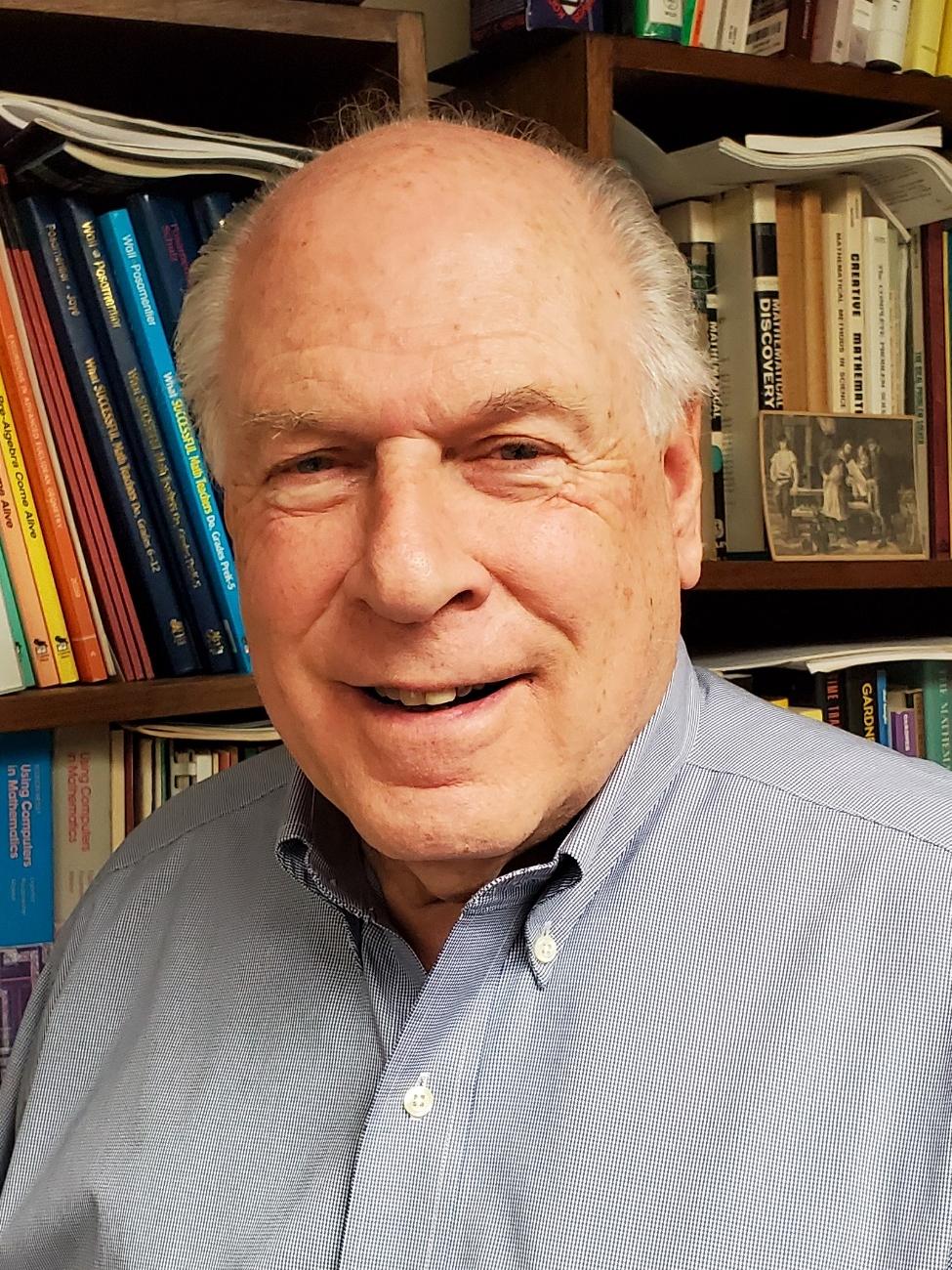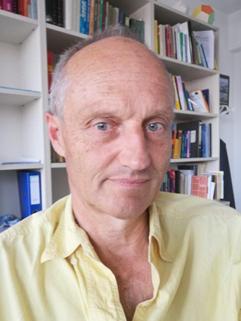Problem Solving in Mathematics and Beyond
Print ISSN: 2591-7234
Online ISSN: 2591-7242
Series Editor: Dr. Alfred S. Posamentier
Distinguished Lecturer
New York City College of Technology - City University of New York
There are countless applications that would be considered problem solving in mathematics and beyond. One could even argue that most of mathematics in one way or another involves solving problems. However, this series is intended to be of interest to the general audience with the sole purpose of demonstrating the power and beauty of mathematics through clever problem-solving experiences.
Each of the books will be aimed at the general audience, which implies that the writing level will be such that it will not engulfed in technical language — rather the language will be simple everyday language so that the focus can remain on the content and not be distracted by unnecessarily sophiscated language. Again, the primary purpose of this series is to approach the topic of mathematics problemsolving in a most appealing and attractive way in order to win more of the general public to appreciate his most important subject rather than to fear it. At the same time we expect that professionals in the scientific community will also find these books attractive, as they will provide many entertaining surprises for the unsuspecting reader.
Published
Vol. 30 Sharpening Everyday Mental/Thinking Skills Through Mathematics Problem Solving and Beyond by Alfred S Posamentier and Hans Humenberger
Vol. 29 Introduction to Chaos, Fractals and Dynamical Systems by Phil Laplante and Chris Laplante
Vol. 28 Seduced by Mathematics: The Enduring Fascination of Mathematics by James D Stein
Vol. 27 Mathematics: Its Historical Aspects, Wonders and Beyond by Alfred S Posamentier and Arthur D Kramer
For the complete list of volumes in this series, please visit www.worldscientific.com/series/psmb
Published by
World Scientific Publishing Co. Pte. Ltd.
5 Toh Tuck Link, Singapore 596224
USA office: 27 Warren Street, Suite 401-402, Hackensack, NJ 07601
UK office: 57 Shelton Street, Covent Garden, London WC2H 9HE
Library of Congress Cataloging-in-Publication Data
Names: Posamentier, Alfred S., author. | Humenberger, Hans, author.
Title: Sharpening everyday mental/thinking skills through mathematics problem solving and beyond / Alfred S. Posamentier (City University of New York, USA), Hans Humenberger (University of Vienna, Austria).
Description: New Jersey : World Scientific, [2024] | Series: Problem solving in mathematics and beyond, 2591-7234 ; volume 30 | Includes index.
Identifiers: LCCN 2023012622 | ISBN 9789811273940 (hardcover) | ISBN 9789811276392 (paperback) | ISBN 9789811273957 (ebook for institutions) | ISBN 9789811273964 (ebook for individuals)
Subjects: LCSH: Problem solving. | Problem solving--Methodology. | Mathematics. Classification: LCC QA63 .P673 2024 | DDC 510--dc23/eng20230911
LC record available at https://lccn.loc.gov/2023012622
British Library Cataloguing-in-Publication Data
A catalogue record for this book is available from the British Library.
Copyright © 2024 by World Scientific Publishing Co. Pte. Ltd.
All rights reserved. This book, or parts thereof, may not be reproduced in any form or by any means, electronic or mechanical, including photocopying, recording or any information storage and retrieval system now known or to be invented, without written permission from the publisher.
For photocopying of material in this volume, please pay a copying fee through the Copyright Clearance Center, Inc., 222 Rosewood Drive, Danvers, MA 01923, USA. In this case permission to photocopy is not required from the publisher.
For any available supplementary material, please visit https://www.worldscientific.com/worldscibooks/10.1142/13342#t=suppl
Desk Editors: Balasubramanian Shanmugam/Rosie Williamson
Typeset by Stallion Press
Email: enquiries@stallionpress.com
Printed in Singapore
AbouttheAuthors
AlfredS.Posamentier iscurrentlyaDistinguished LecturerattheNewYorkCityCollegeofTechnologyoftheCityUniversityofNewYork.Priorto that,hewastheExecutiveDirectorforInternationalizationandFundedProgramsatLongIslandUniversity,NewYork.Thiswasprecededby5years astheDeanoftheSchoolofEducationandProfessorofMathematicsEducationatMercyUniversity, NewYork.Beforethat,hewasattheCityCollege oftheCityUniversityofNewYorkfor40years,atwhichheisnowthe ProfessorEmeritusofMathematicsEducationandtheDeanEmeritusof theSchoolofEducation.Heistheauthorandco-authorofmorethan80 mathematicsbooksforteachers,secondaryandelementaryschoolstudents, aswellasthegeneralreadership.Dr.Posamentierisalsoafrequentcommentatorinnewspapersandjournalsontopicsrelatedtoeducationand mathematics.
AftercompletinghisB.A.degreeinmathematicsatHunterCollege oftheCityUniversityofNewYork,hetookapositionasateacherof mathematicsatTheodoreRooseveltHighSchool(Bronx,NewYork),where hefocusedhisattentiononimprovingstudents’problem-solvingskillsand atthesametimeenrichingtheirinstructionfarbeyondwhatthetraditional textbooksoffered.Duringhis6-yeartenurethere,healsodevelopedthe
school’sfirstmathematicsteams(bothatthejuniorandseniorlevels).Heis stillinvolvedinworkingwithmathematicsteachersandsupervisors,nationallyandinternationally,tohelpthemmaximizetheireffectiveness.
ImmediatelyuponjoiningthefacultyoftheCityCollegeofNewYork in1970(afterhavingreceivedhismaster’sdegreetherein1966),hebegan todevelopin-servicecoursesforsecondaryschoolmathematicsteachers, includingsuchspecialareasasrecreationalmathematicsandproblemsolvinginmathematics.AstheDeanoftheCityCollegeSchoolofEducation for10years,hisscopeofinterestcoveredthefullgamutofeducational issues.Duringhistenure,hetooktheschoolfromthebottomoftheNew YorkStaterankingstothetopwithaperfectNCATEaccreditationassessmentin2009.Healsoraisedmorethan12milliondollarsfromtheprivate sectorforinnovativeeducationprograms.Dr.Posamentierrepeatedthis successfultransitionatMercyUniversity,whereheenabledittobecome theonlycollegetohavereceivedbothNCATEandTEACaccreditation simultaneously.
In1973,Dr.PosamentierreceivedhisPh.D.fromFordhamUniversity (NewYork)inmathematicseducationandhassinceextendedhisreputationinmathematicseducationtoEurope.Hehasbeenavisitingprofessor atseveralEuropeanuniversitiesinAustria,England,Germany,theCzech Republic,Turkey,andPoland.In1990,hewastheFulbrightProfessorat theUniversityofVienna.
In1989,hewasawardedanHonoraryFellowpositionatSouthBank University(London,England).Inrecognitionofhisoutstandingteaching, theCityCollegeAlumniAssociationnamedhimEducatoroftheYearin 1994and2009.NewYorkCityhadtheday,May1,1994,namedinhis honorbythePresidentoftheNewYorkCityCouncil.In1994,hewas alsoawardedthe DasGrosseEhrenzeichenfürVerdiensteumdieRepublik Österreich (GrandMedalofHonorfromtheRepublicofAustria),andin 1999,uponapprovalofParliament,thePresidentoftheRepublicofAustria awardedhimthetitleof UniversityProfessorofAustria.In2003,hewas awardedthetitleof Ehrenbürgerschaft (HonoraryFellow)oftheVienna UniversityofTechnologyand,in2004,wasawardedthe Österreichisches EhrenkreuzfürWissenschaft&Kunst1.Klasse (AustrianCrossofHonor forArtsandScience,FirstClass)fromthePresidentoftheRepublicof
Austria.In2005,hewasinductedintotheHunterCollegeAlumniHallof Fame,andin2006hewasawardedtheprestigious TownsendHarrisMedal bytheCityCollegeAlumniAssociation.HewasinductedintotheNew YorkStateMathematicsEducator’sHallofFamein2009,andin2010he wasawardedthecoveted Christian-Peter-BeuthPrize fromtheTechnische Fachhochschule,Berlin.In2017,Dr.Posamentierwasawarded Summa CumLaudenemminediscrepante bytheFundacionSebastian,A.C.,Mexico City,Mexico.
Hehastakenonnumerousimportantleadershippositionsinmathematicseducationlocally.HewasamemberoftheNewYorkStateEducation Commissioner’sBlueRibbonPanelontheMath-ARegentsExams,and theCommissioner’sMathematicsStandardsCommittee,whichredefined theMathematicsStandardsforNewYorkState,andhealsoservedonthe NewYorkCityschools’Chancellor’sMathAdvisoryPanel.
Dr.Posamentierisstillaleadingcommentatoroneducationalissues andcontinueshislong-timepassionofseekingwaystomakemathematics interestingtoteachers,students,andthegeneralpublic—ascanbeseen fromsomeofhismorerecentbooks.
Formoreinformationandalistofhispublications,seehttps:// en.wikipedia.org/wiki/Alfred_S._Posamentier.
HansHumenberger iscurrentlyafullProfessor ofMathematicswithspecialemphasisonmathematicseducationattheUniversityofVienna(Austria).Hebeganhiscareerstudyingmathematics andsportsattheUniversityofVienna.Inthe1990s hewasahighschoolteacheratseveralViennese highschoolsandalsoagraduate-assistantatthe UniversityofNaturalResourcesandLifeSciences,InstituteforMathematics,Vienna.In1993 heearnedhisPh.D.attheUniversityofVienna,and1998hereceived hishabilitationinthefieldofmathematicseducation.Between2000and 2005hewasAssistantProfessorofmathematicsattheUniversityofDortmund(Germany).Duringthistime,healsospentahalfyearasInterim ProfessorattheUniversityofDuisburg-Essen(Germany).Hereturnedto
Viennain2005toaccepthiscurrentprofessorshipformathematicsatthe UniversityofVienna.Sincethen,hehasbeentheheadofaworkinggroup “DidacticsofMathematicsandSchoolMathematics”andalsoresponsible fortheeducationaltrainingofpreservicemathematicsteachersforsecondaryschool.
OfparticularnoteistheforthcomingGermantitle Anschauliche Elementargeometrie, writtenwithhisformercolleagueBertholdSchuppar,whichisageometrybookintendedlargelyforfutureteachersof mathematics.
Hehasbeeninterestedinmathematicsproblemsolvingformanyyears, whichisreflectedinseveralpapersandcorrespondingseminarsforpreservicemathematicsteachers,whichhehasheldatseveraluniversities.
In2007,heestablishedanopportunityforsecondaryschoolstudents (grades5–8)toattendseminars/workshopsattheUniversityofViennato exploreinterestingandchallengingproblems.Thissuccessfulprogramis fundedbytheViennaDepartmentofEducationandcontinuestothepresent day.Furthermore,heisparticularlyinterestedinmakingmathematicsinterestingforthegeneralaudiencesincethisisimportantforthegeneralperceptionofmathematicsinoursociety.
Since2007hehasbeeneditorofanAustrianschooltextbookseriesin mathematicsforgrades5–8,andin2022hewasamemberofacommittee thatestablishedanewsyllabusformathematicsatprimaryandsecondary schoollevelsinAustria.
Hismainfieldsofinterestaremathematicsasaprocess,applicationsof mathematics,problemsolving,geometry,andstochastics.
Moredetailsandacompletelistofhispublicationscanbefoundatthe followingwebsite:https://homepage.univie.ac.at/hans.humenberger/.
AbouttheAuthors v Introduction xi
Chapter1.ArithmeticCalculationSurprises1
Chapter2.NumericalNovelties41
Chapter3.ChallengingProblemswithSurprisingSolutions113
Chapter4.Algebra:AUniqueProblem-SolvingTool173
Chapter5.GeometricGems219
Chapter6.ForExperts:StepwiseSolutionsto ChallengingProblems277
Index 319
This page intentionally left blank
Introduction
Thisbookisintendedtosharetheusefulness,powerandbeautyofmathematicswiththegeneralpublicandbeyond!Mathematicsisasubjecttaught atallgradesfromkindergartenthroughhighschool,andyetitistheonesubjectthatmostadultsarealmostproudtoadmitnothavingbeenverygood atand,therefore,tendtoavoiditwheretheycan.This,unfortunately,is sometimespassedontochildren,whichextendsthisnegativelegacy.Thisis regrettableasitindirectlytendstolimitaperson’sreasoningability,which issomethingthatistrainedthroughoutallofmathematicsinstruction— albeitoftentimesindirectly.Onewonderswhythiscontinuestobethecase decadeafterdecade.Attheelementaryschoollevel,teacherswhoreflect thegeneralpublicareamongthosewhoarenotveryenamoredwithmathematics.Consequently,theydonotexertthemselvestomakethesubject interestingandexcitingandarelargelyfocusedon“teachingtothetest.”
Webelievethisisahugedisservicetothestudents.Atthesecondaryschool level,mathematicsteachershavetheopportunitytogenerateanewinterest inmathematics,yettheytooareconcernedaboutstudenttestperformance and,therefore,rarelydeviatefromthestandardcurriculum.Itisexactlythat measureddeviationthatwebelieveisessentialtodemonstratethebeautyof mathematics,whichinturncangenerateorrekindleaninterestamongthe students.Thereisamultitudeoftopicsandskillsinmathematicstowhich studentsareneverexposed.Inthisbook,weareattemptingtodemonstrate notonlytotheteachersbut,inlargemeasure,tothegeneralpublic,the wondersthatarehiddeninmathematicsandthatcanmakeitaverypopular subjectbothinschoolandbeyond.
Chapter1appropriatelypresentsawidevarietyofarithmeticcalculations,whichgofarbeyondthefourbasicoperations:addition,subtraction, multiplication,anddivision.Hereweinvestigateunusualandnotwellknowncalculationsandcalculatingshortcutsthatnotonlygiveagenuine insightintoarithmeticoperationsbutalsoimprovearithmeticskillsboth inwritingandinthinking.ThisleadsusnicelyintoChapter2,which presentsawidespectrumofnumericalnoveltiesthatprovidesanextraordinaryviewofnumberrelationshipsandnumericalpropertiesthatcango alongwaytoimpressthegeneralreadershipaboutthehiddenbeautiesin mathematics.
Oneofthekeyfactorsinmathematicsisitsabilitytoenableustosolve problems.Learninghowtosolvemathematicalproblemsoftenhasafavorablespin-offtosolvingeverydayproblems.Forexample,therearetimes whenwedealwithaneverydaysituationwhereweconsider“theworst-case scenario”ofthesituation,whichisanalogoustosolvingamathematical problembyconsideringextremes.Orwemightconsiderthebestpathto takefrompointAtopointB,wheregeometricrelationshipscanbehelpful. Thesearejustsomeoftheeverydayproblemsthatabroadbackgroundin mathematicsproblemsolvingcanbesupportive.Therefore,Chapter3of thisbookfocusesonproblem-solvingstrategiesinmathematics,whichare intendedtobebothentertainingandinstructional.Oneofthemostbasic toolsinmathematicsisalgebra,whichallowsustounderstandthegeneral caseofcertainideasandconcepts,andalsotodiscoveranswerstocomplicatedproblems.Chapter4focusesonalgebraanditssomewhatunusual applications,whichareintendedtostrengthenalgebraicskillswhileatthe sametimedemonstratingitspower.Asasidebenefit,itcontributestoa morefavorablefeelingtowardsthesubjectofmathematicsingeneral.
Chapter5highlightstheoneaspectofmathematicsthatclearlydemonstratesitbeauty,whichisgeometry,perhapstheoldestbranchofthefield ofmathematics,asitallowsustoappreciatephysicalrelationshipsthat aresometimescounterintuitiveand,thereby,canbehighlymotivating.The geometrythatisofferedhereisbeyondthatwhichistaughtatthesecondary schoollevelyetrequiresnothingmorethansomebasicstaughtinschool.
Finally,inChapter6weprovideasomewhatmorechallengingtopic thanofferedinthepreviouschapters,asitexploresaproblemsolving
Introduction xiii
technique,whichrequiresabitofpatienceasitdealswithproblemsin astepwiseprocedure.Thatis,ratherthantoattacktheproblemwithan immediateelegantsolution,wepresentproblemsthatcanbeveryneatly solvedbyfirstconsideringvariousminorstepsthatwillleadtoaproper solution.
Initstotality,thisbookisintendedtodemonstrateavarietyof neglectedaspectsofmathematicsthatcanregenerateinterestinthesubjectforthegeneralreadershipaswellasforteacherswhowill,hopefully, provideasignificanttimeslotintheirteachingeachweektomotivatestudentswithsomeoftheamazingaspectsofmathematicswehighlight.In short,wehopethatthisbookwillgoalongwaytopopularizethefield ofmathematicsbydemonstratingitspowerandbeautybeyondwhere mostpeoplebelieveispossible.So,joinusnowaswebeginourjourneythroughamyriadofsurprisingaspectsofthismostimportantsubject: mathematics.
This page intentionally left blank
Chapter1
ArithmeticCalculationSurprises
Althoughintoday’sculturearithmeticskillshavebeenrelegatedtocomputersandcalculators,thereisstillagreatadvantagetohaveinsightinto arithmeticcalculations.Theycannotonlybehelpfulandsometimeseven swifterthanacalculator,butalsoasatoolforappreciatingmathematics anditslogic.Tomultiplyatwo-digitnumberby11canbedonemore quicklymentallythanwithacalculator,ifoneknowsthatthisproductcan beobtainedbytakingthesumofthedigitsofthetwo-digitnumberand placingitbetweenthetwodigitsasisthecasewith53 × 11 = 583.Naturally,whenthesumofthedigitsexceeds9,slightadjustmentsmustbe made,suchascarryingthe1tothetensplace.Therearemanyastonishing arithmeticrelationshipsthathavebeendiscoveredoverthepastcenturies. Inthischapter,wewillhighlightmerelyafewwiththehopethatthereader willbemotivatedtoseekoutothers.Anoteonsymbolsformultiplicationin thisbook:Therearevariouswaystoindicatemultiplication.Thefirstoneis thesmall ×;asecondoneisacentereddot;andathirdoneissimplyusing nosymbolaswith2 y or ab .Inthisbookwewilluseallthreeversionsas mostconvenient.
CleverAddition
Oneofthemostpopularlyrepeatedstoriesfromthehistoryofmathematics isthetaleofthefamousmathematicianCarlFriedrichGausswhoatage10 wassaidtohavementallyaddedthenumbersfrom1to100inresponsetoa
busyworkassignmentgivenbytheteacher.1 Althoughitisacutestoryand generallygetsaveryfavorablereaction,ithappenstoprovideuswithaneat littleformulaforaddingnumbersinanarithmeticsequence,whichisalist ofnumbersthathasacommondifferencebetweenconsecutivenumbers.
Forexample,2, 4, 6, 8, 10,... isanarithmeticsequenceasiseachofthe following:
Perhapsthesimplestarithmeticsequenceisthenaturalnumbers: 1, 2, 3, 4, 5,... .WhatGaussdidtogetthesumofthefirst100natural numberswithoutwritingasinglenumberwas not toaddthenumbersinthe orderinwhichtheyappearbutrathertoaddtheminthefollowingway: thefirstplusthelast, thesecondplusthenext-to-last, thethirdplusthethirdfromlast, andsoon.
Ifwedothis,wegetthefollowing:
Noteeachpairhasthesamesumof101.Thesumofthese50pairsof numbersis50 × 101 = 5,050.Fromthisexample,wecanderiveauseful formulaforaddingnumbersinanarithmeticsequence.Weaddedthefirst andthelastandmultipliedthissumbyone-halfthenumberofmembersof
1 AccordingtoE.T.Bellinhisbook, MenofMathematics (NewYork:Simon&Schuster, 1937),theproblemgiventoGausswasofthesort:81297 + 81495 + 81693 +···+ 100899, wherethecommondifferencebetweenconsecutivetermswas198andthenumberofterms was100.Today’sloreusesthenumberstobesummedfrom1to100,whichmakesthepoint justaswellbutinsimplerform.
thesequence.Wecangeneralizethisandgetaformulaforanarithmetic seriesof n terms(with n anevennumber),where a isthefirsttermand l isthelastterm(usingGauss’method)asfollows:Sum = n 2 (a + l ).This formulaturnsouttobecorrectalsointhecasethat n isanoddnumber, whereinthiscase a + l isanevennumber.Here,wehaveanexampleof howsimpleitistoderiveaveryusefulmathematicalformula,onebased onaverylovelypatternthatwasn’tcompletelyobviousinitially.
SurprisingAddition
Thereisnotmuchonecansaybeyondadmiringthefollowingresultsand appreciatingthesurprisesthattheadditionofnaturalnumbersoffers:
SurprisingDivision
Somenumberslendthemselvestoaverybeautifulsymmetricdivision, whichcanbebestdemonstratedasfollows:
Thispatterncontinuesforfourfurtherstepsuntilthedigit9inthemiddle isreached.
SurprisingMultiplicationResults
Whenthenumber076923ismultipliedbythenumbers1,10,9,12,3,and4, quiteasurprisingpatternresults;withthenumbersstayinginthesameorder, beginningwiththemultiplicationby10,thedigitofthepreviousresultfar leftismovedwitheachmultiplicationtothefarright.Furthermore,ifyou inspecttheverticalarrangementsoftheresultingnumbers,youwillfindthe samepattern.
076923 × 1 = 076923
076923 × 10 = 769230
076923 × 9 = 692307
076923 × 12 = 923076
076923 × 3 = 230769
076923 × 4 = 307692
Ananalogouspatterncanbeobtainedbymultiplyingthenumber76923 bythenumbers2,7,5,11,6,and8asfollows:
76923 × 2 = 153846
76923 × 7 = 538461
76923 × 5 = 384615
76923 × 11 = 846153
76923 × 6 = 461538
76923 × 8 = 615384
Onceagainyouwillnotetheverticalarrangementofthedigitsofthe numbersontherightsideoftheequalsignisanalogoustothehorizontal arrangements.
UsingAllNineDigitstoMake100
Thechallengehereistouseall9digits1,2,3,4,5,6,7,8,and9tocreate anintegerplusafractionwhosesumis100.Hereare11waysinwhichthis canbedone.Anambitiousreadermaywishtoseekothers.
CalculationSurprises
Considerthefollowingadditionandmultiplicationpatterns.Thisisanother exampleofthehiddenbeautyofmathematics.
Considerthefollowingmultiplicationandsubtractionpattern:
Considerthefollowingsymmetryinvolvingdivisionandaddition:
Lastly,considerasymmetrybetweendivisionandsubtraction:
SquaringaMultipleof5
Considerthechallengeofsquaringthenumber85mentally.Hereisa waythatyoucanperformthiscalculationrathereasily.Allweneedto do,followingthiscurioustechnique,istomultiplythetensdigit,which is8,by8 + 1 = 9,thenmultiplythatby100andadd25,asshown here:852 = (8 × 9 × 100) + 25 = 7225.Withalittlepractice,this cangoquitequicklyandprovideanotherusefularithmetictechnique.To seewhythisworks,let’sconsiderageneralcaseofatwo-digitnumber (10a + 5),whichisamultipleof5.Whenwesquarethisnumber,weget (10a + 5)2 =
SquaringNumbersfrom1to125
Thistechniquerequiresustopartitionthenumbersfrom1to125intothree groups:
(1)Thesquaresofthefirst25numbers1–25aremostlikelyknownby manypeoplewithoutcalculation.
Thesquaresofthenumbers25–70aresymmetricaboutthenumber 50,as25–50–75,andtheirsquarescanbecalculatedeasilywiththe followingtechnique:
Addto(subtractfrom)25thedistanceofthenumberto50andappend ontherightitssquareasatwo-digitnumber(however,ifthissquare isathree-digitnumber,thencarryitshundredsdigittothelastdigitof thefirstoperation).
SharpeningEverydayMental/ThinkingSkills
Thiscanbeeasilyshownwiththefollowingexamples:
572 :25 + 7 = 32; 72 = 4932 |49, whichisthenumber3,249
362 :25 14 = 11; 142 = 196,then11 + 1 | 96or12 |96,whichis thenumber1,296
Thisalwaysworksbecause (50 ± a )2 = 2500 ± 100a + a 2 =
(25 ± a ) · 100 + a 2 .
Ifoneallows a toalsobenegative,thenonedoesnotneedtodistinguish between50 ± a ,onecanjustwrite (50 + a )2 = 2500 + 100a + a 2 = (25 + a ) 100 + a 2 .
(2)Thesquaresofthenumbersbetween75and125(whicharesymmetric about100aswecanseewith75–100–125)canbecalculatedeasily usingthefollowingtechnique:
Addto(subtractfrom)thenumberitsdistanceto100andthenappend ontherightthesquareddistanceasatwo-digitnumber.
Considerthefollowingexamples:
1062 :106 + 6 = 112; 62 = 36112 | 36, whichisthenumber11,236
882 :88 12 = 76; 122 = 144then76 + 1|44or77 | 44, whichis thenumber7,744
Thereasonthatthisworkscanbeshownasfollows: (100 ± a )2 = 1002 ±2(100a )+a 2 = (100±2a )(100 )+a 2 = [(100±a )±a ](100)+a 2
Ifoneallows a toalsobenegative,thenonedoesnotneedtodistinguishbetween100 ± a .
TheUnusualNumber9
ThefirstoccurrenceinWesternEuropeoftheHindu–Arabicnumeralswe usetodaywasinthebook Liberabaci writtenin1202byLeonardoofPisa (commonlyknownasFibonacci).
Hebeginsthebookwithanintroductionthatreads: thesearetheninefiguresoftheIndians9,8,7,6,5,4,3,2,1.With theseninefigures,andwiththesymbol,0,whichinArabiciscalled zephirum,anynumbercanbewritten,aswillbedemonstrated ...
Withthisbook,theuseofthesenumeralswasfirstpopularizedinEurope. Beforethat,Romannumeralswereused,whichwereclearlymuchmore cumbersometouseforcalculation.Fascinatedashewasbythearithmetic calculationsusedintheIslamicworld,Fibonacci,inhisbook,firstintroducedthesystemof“castingoutnines”2 asacheckforarithmetic.Itcomes inhandyeventoday.However,thenicethingaboutitisthatitagaindemonstratesahiddenmagicinordinaryarithmetic.
Beforewediscussthisarithmetic-checkingprocedure,wewillconsider howtheremainderofadivisionby9comparestoremovingninesfrom thedigitsumofthenumber.When8,768isdividedby9,thequotientis 974witharemainderof2.Thisremaindercanalsobeobtainedby“casting outnines”fromthedigitsumofthenumber8,768:Wewillfindthesum ofthedigitsand,ifthesumismorethanasingledigit,weshallrepeat theprocedure.Inthecaseofourgivennumber,8,768,thedigitsumis29 (8 + 7 + 6 + 8 = 29)sowewillrepeattheprocess.Again,thecasting-outninesprocedureisusedtoget2 + 9 = 11,andagain1 + 1 = 2,whichwas, infact,theremainderwhenwedivided8,768by9.
Wecanusecastingoutninestocheckifamultiplicationproblemiscorrect.Supposewewouldliketomultiply734 × 879.Theanswerwegetis 645,186.Nowcastingoutninesbytakingdigitsums,wegetthefollowing:
For734:7 + 3 + 4 = 14;then1 + 4 = 5
For879:8 + 7 + 9 = 24;then2 + 4 = 6
Fortheproductofthesetwo numbers,645,186:6 + 4 + 5 + 1 + 8 + 6 = 30
Since5 × 6 = 30,whichyields3(castingoutnines:3 + 0 = 3),is thesameasforthesumofthedigitsoftheproduct,theanswercouldbe correct.Forpractice,wewilldoanothercasting-out-nines“check”forthe followingmultiplication:56, 589 × 983, 678 = 55, 665, 354, 342.
For56, 5895 + 6 + 5 + 8 + 9 = 33; 3 + 3 = 6
For 983, 6789 + 8 + 3 + 6 + 7 + 8 = 41; 4 + 1 = 5
2 “Castingoutnines”referstoanarithmeticcheckthattellsyouifyouranswerispossibly correct.Theprocessrequirestakingbundlesofninesawayfromthesumofthedigits.
Theproductoftheremainders:5 × 6 = 30 → 3 + 0 = 3,compares favorablytothedigit-sumremainderasweseehere:
55, 665, 354, 342:5 + 5 + 6 + 6 + 5 + 3 + 5 + 4 + 3 + 4 + 2 = 48; 4 + 8 = 12; 1 + 2 = 3
Thesameprocedurecanbeusedtocheckthelikelihoodofacorrect sum,difference,orquotient,simplybytakingthesum(differenceorquotient)andcastingoutnines,takingthesum(differenceorquotient)ofthese “remainders,”andcomparingitwiththeremainderofthesum(differenceor quotient).Ifthesedigit-sumremaindersarenotequaltheanswerissurely wrong.Ifthesedigit-sumremaindersareequal,theanswerhasagood chancetobecorrect.
MoreNoveltieswiththeNumber9
Thenumber9hasanotherunusualfeaturethatenablesustouseasurprising multiplicationalgorithm.Althoughitissomewhatcomplicated,itisneverthelessfascinatingtoseehowitfunctionsandperhapstrytodeterminewhy thisactuallyworks.Thisprocedureisintendedformultiplyinganumber oftwodigitsormoreby9.Itisperhapsbesttodiscusstheprocedurein thecontextofanactualexample:Considermultiplying76, 354 × 9.Now followthestepsshowninFigure1.1.
Step 1
Step 2
Step 3
Subtract the units digit of the multiplicand from 10 10 – 4 = 6
Subtract each of the remaining digits (beginning with the tens digit) from 9 and add this result to the previous digit in the multiplicand (for any two digit sums, carry the tens digit to the next sum)
– 5 = 4, 4+ 4 = 8
– 3 = 6, 6 + 5 = 11, 1
– 6 = 3, 3 + 3 = 6, 6 + 1 = 7 9 – 7 = 2, 2 + 6 = 8
Subtract 1 from the left-most digit of the multiplicand 7 – 1 = 6
Step 4 List the results in reverse order to get the desired product 687,186
Figure1.1
Althoughitisabitcumbersome,especiallywhencomparedtoacalculator,thisalgorithmprovidessomeinsightsintonumbertheory.
Non-RepeatingEight-DigitNumbersandtheNumber9
Therearemanyeight-digitnumberswithnodigitsrepeatedthatwhenmultipliedby9yieldnine-digitnumberswhichhavesomedigitsrepeated,such as56, 387, 412 × 9 = 507, 486, 708.However,therearesomeinstancesin whichanon-repeating-digiteight-digitnumbermultipliedby9resultsina nine-digitnumberwithnorepeatingdigitssuchas
81274365 × 9 = 731469285
76125484 × 9 = 685129347
72645831 × 9 = 653812479
58132764 × 9 = 523194876
Curiouslyenough,whenthesefourproductsofninedigitsaremultiplied by2,theresultisonceagaina10-digitnumberwithnorepeatingdigitsas wecanseewiththefollowing:
731469285 × 2 = 1462938570
685129347 × 2 = 1370258694
653812479 × 2 = 1307624958
523194876 × 2 = 1046389752
Onceagain,thenumber9playsanimportantroleinourarithmetic wonders!
TheMagicoftheNumber9
Theonlypeculiarityofthenumber12,345,679isthatithasthedigitsin sequenceandismissingthenumber8.Ifwemultiplythisnumberbyproductsof9withanyofthenumbers1,2,3,4,5,6,7,8,and9,wegetsurprising results:
SharpeningEverydayMental/ThinkingSkills
9 × 3 × 12, 345, 679 = 333, 333, 333
9 × 4 × 12, 345, 679 = 444, 444, 444
9 × 5 × 12, 345, 679 = 555, 555, 555
9 × 6 × 12, 345, 679 = 666, 666, 666
9 × 7 × 12, 345, 679 = 777, 777, 777
9 × 8 × 12, 345, 679 = 888, 888, 888
9 × 9 × 12, 345, 679 = 999, 999, 999
Thisunusualfeaturecanbeeasilyexplained,since n × 9 = n (10 1).Nowmultiplyingthenumber n (10 1) by12,345,679givesus n (123, 456, 790 12, 345, 679) = n (111, 111, 111).
ASecretabouttheNumber9
Thereisacuriositywhenthenumber15isplacedbetweenthedigitsofthe number42 = 16.
1156 = 342
Whenweplacethenumber15inthemiddleofthenumber1156,we get1115 56 = 3342 .
Whenweplacethenumber15inthemiddleofthenumber111556,we get11115 556 = 33342 .
Whenweplacethenumber15inthemiddleofthenumber11115556, weget111115 5556 = 333342 .Thispatterncontinues.Theproblemisto showwhythiscontinuestoworkfurtheron.
Solution: Wecanunderstandthispatternbyconsideringanyoneofthenumbersinourpattern,say,11115556,whichwhenmultipliedby9isequalto 100040004 = 10002 2 .Thiscanbeshowntoholdtruebyanalyzingthe productasfollows:11115556 × (10 1) = 111155560 11115556 = 100040004.Atthispoint,weshouldnotethatnumbersoftheform “1000 ... 4000 ... 4”arealwayssquarenumbers.Rememberthiswasgeneratedbythenumber9.
Thereisoneothernumber,48,thatcananalogouslygeneratesquare numbers.Thistimewebeginwiththenumber49andplacethenumber
48betweenthecenterdigitssothatthenextnumberwillbe448 9 = 67 2 . Andthen4448 89 = 6672 ,and44448 889 = 66672 ,andsoon.Onceagain, itisthenumber9thatgeneratesthispatternasfollows:444889 × 9 = 4004001 20012 .
TheTechniqueforDeterminingWhenaNumberis Divisibleby3or9
Therearemomentsineverydaylifesituationswhereitcanbeusefulto knowifanumbercanbedivisibleby3orby9,especiallyifitcanbedone instantly“inyourhead.”Forexample,ifyouareinarestaurantandreceive acheckof$71.23,andyouwanttoaddatipbutyouwouldwanttheend resulttobeabletobesplitevenlyamongthreepeople.Wouldn’titbenice ifthereweresomementalarithmetictechniquefordeterminingthis?Well, herecomesmathematicstotherescue.Wearegoingtoprovideyouwitha simpletechniquetodetermineifanumberisdivisibleby3and(asanextra bonus)alsodivisibleby9.
Therule,simplystated,isasfollows:
If,andonlyif,thesumofthedigitsofanumberisdivisibleby3(or9), theoriginalnumberisdivisibleby3(or9).
Asbefore,perhapsanexampleofthistechniquewouldbestfirmupan understandingofhowitworks.Considerthenumber296,357.Let’stestit fordivisibilityby3(or9).Thesumofthedigitsis2 + 9 + 6 + 3 + 5 + 7 = 32, whichisnotdivisibleby3or9.Therefore,theoriginalnumberisneither divisibleby3nor9.
Let’snowassumeagroupofthreepeopleisgivenarestaurantcheckof $71.23andwouldliketogiveanapproximate20%tiponthischeck.They decidetoadd$14tothebill,whichwouldmakethetotal$85.23.Tocheck fordivisibilityby3,sincetheywouldliketodividethecheckequallyamong thethreepersons.Thethreeparticipantswouldhavethemaddthedigitsto get8 + 5 + 2 + 3 = 18,whichisdivisibleby3and,therefore,wouldallow themtoequallydividethecheckamongthethreecustomers.Ifthenumber reachedfromthesumofthedigitsisnoteasilyidentifiableasamultipleof 3,thencontinuetoaddthedigitsofthatnumberuntilyoureachanumber thatyoucaneasilyrecognizeasamultipleof3.Inthiscase,itshouldbe
notedthatthefinalresult,18,isalsodivisibleby9,whichimpliesthatthe originalnumberwasdivisibleby9aswell.
Hereisabriefexplanationaboutwhythisruleworks.Considerthe number ab,cde,whosevaluecanbeexpressedas(where9 M referstoa multipleof9)
whichimpliesthatdivisibilitybynineofthenumber N dependsonthe divisibilityof a + b + c + d + e ,whichisthesumofthedigits.
Afewexamplestofirmupthistechniqueareasfollows:
Isthenumber457,875divisibleby3or9?Thesumofthedigitsis 4 + 5 + 7 + 8 + 7 + 5 = 36,whichisdivisibleby9(andthen,ofcourse, by3aswell),sothenumber457,875isdivisibleby3andby9.
Isthenumber27,987divisibleby3or9?Thesumofthedigitsis 2 + 7 + 9 + 8 + 7 = 33,whichisdivisibleby3butnotby9.Therefore,the number27,987isdivisibleby3butnotby9.
Nowthatyouareanexpertatdeterminingifanumberisdivisibleby 3or9,wecangobacktotheoriginalquestionaboutthedivisibilityofa restaurantbillof$71.22 + 14.00 = $85.22.Canitbedividedintothree equalparts?Because8 + 5 + 2 + 2 = 17,and17isnotdivisiblebythree, therefore$85.22isnotdivisibleby3,andtheywillhavetomodifythetip to geteveryonetopaythesameamount.
Multiplyingby11Mentally
Multiplyingby11canbesignificantlysimplerthanusingacalculator,and yet,thistechniqueishardlyeverpresentedinschool.Whatashame!When multiplyingby11,thetechniquefordoingitisasfastasyoucanwritethe numberyouaremultiplyingby11.Forexample,supposeyouwouldlike
tomultiply23 × 11.Allyouneedtodoisaddthedigits,2 + 3 = 5,and placethatdigit5betweenthetwodigitsinthenumber23toget253.What couldbeeasier!Wecanstatethistechniqueasfollows:
Tomultiplyatwo-digitnumberby11,justaddthetwodigitsandplace thissumbetweenthetwodigits.Ifthesumofthedigitsisatwo-digitnumber, thencarrythetensdigitofthesumtobeaddedtotheformertensdigit.
Justforpractice,wewillapplythistechniquetomultiply45by11. Accordingtotherule,add4and5andplaceitbetweenthe4and5toget 495.Thistechniquecangetabitmoredifficultwhenthesumofthetwo digitsyouneedtoaddresultsinatwo-digitnumber.Wenolongerhavea singledigittoplacebetweenthetwooriginaldigits.So,ifthesumofthe twodigitsisgreaterthan9,thenwewouldplacetheunitsdigitofthatsum betweenthetwodigitsofthenumberbeingmultipliedby11and“carry” thetensdigittobeaddedtothehundredsdigitofthemultiplicand.Let’s tryitwith78 × 11.Wefindthatthesumofthetwodigitsis7 + 8 = 15. Therefore,weplacethe5betweenthe7and8andaddthe1tothe7toget [7 + 1][5][8]or858.
Youmaylegitimatelyaskiftherulealsoholdswhen11ismultipliedby anumberofmorethantwodigits.Consideralargernumbersuchas12,345 andusethistechniquetomultiplyitby11.
Here,webeginattheright-sidedigitandaddeverypairofdigitsgoing fromrighttoleft.
1[1 + 2][2 + 3][3 + 4][4 + 5]5 = 135, 795.
Supposewenowcombinetheskillwehavegarneredthroughthistechniqueofmultiplyingby11andapplyittoanumber,whichrequiresamore complicatedversion,wherethesumofadjacentdigitsexceeds9.Remember, ifthesumoftwodigitsisgreaterthan9,thenusetheproceduredescribed earlier:Placetheunitsdigitofthistwo-digitsumappropriatelyandcarrythe tensdigittothenextplace.Tobecomeanexpertatthisprocedure,wewill dooneofthesemorecomplicatedversionshere.Letusconsidermultiplying 56,789by11.Thismaybealittlebittedious,andperhapssomewhatless realisticforcommonuse,butwewillshowitheremerelytodemonstrate theextensionofthismultiplicationtechnique.Followalongaswedothis stepbystep.
